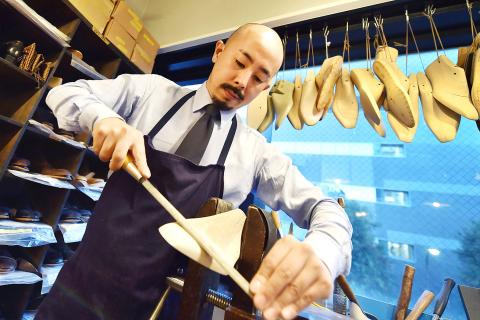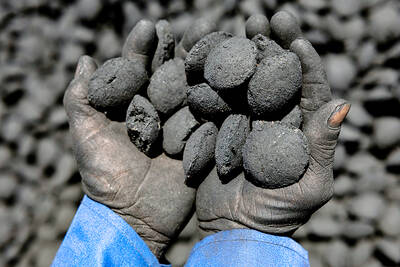When Yohei Fukuda left for England more than a decade ago to learn his trade as a master leather shoemaker, he could hardly have imagined that his native Japan would one day become a leader in this traditionally European art.
“The number of bespoke shoe workshops has been booming in Japan in the past few years,” the elegant-looking bald and mustachioed 37-year-old said, sporting a smart shirt and tie under a dark-blue work apron.
“There are at least 40 in Tokyo today, and maybe as many as 100 in the whole country,” Fukuda told reporters.

Photo: AFP
Bespoke leather shoemaking has historically been dominated by European artisans, but Japan developed a taste for the luxury footwear at the beginning of the 2000s and local manufacturing classes quickly took off.
Fukuda’s workshop is located close to the upmarket area of Ometesando in Tokyo, often described as Japan’s answer to the grand Champs Elysee avenue in Paris. A narrow staircase leads up to his old-fashioned workspace that smells strongly of leather and glue, the basic tools of the trade.
There is not one machine in the whole place — everything is done by hand, from the precise measurement of a client’s feet to the delicate business of attaching the soles to the shoe.
“Each pair of shoes takes between 120 and 140 hours of work and we produce around 80 a year,” Fukuda said.
He does not want to go at a faster pace: “I want to make good shoes,” he added.
Fortunately, his customers are in no hurry and willing to pay a hefty price for the bespoke quality — a 100 percent made-to-measure pair costs at least ¥480,000 (US$4,304).
Why Japan?
Mari Yamaguchi, who teaches the meticulous trade in a private school in the trendy Harajuku area of Tokyo, said that bespoke shoes “speak to the Japanese spirit, with its sense of detail.”
At Yamaguchi’s school, dozens of young students are bent over workbenches, carefully learning each one of the individual painstaking steps required in the manufacturing process.
“A foot is something very special. Each foot is unique, like each piece of leather. When making bespoke shoes by hand, the challenge is to get close to perfection by bringing together these two imperfect, but magic elements,” she said.
“Maybe Japanese people think about shoes more than in other cultures, because most people put them on and take them off several times a day — whenever entering a house,” the 43-year-old teacher said.
Not for the first time, the Japanese have traveled abroad to adopt the skills and then improved them, said Jesper Ingevaldsson, Swedish author of a specialist blog on shoemaking.
“They have done with shoes what they have done with other things, like denim, for example: they learn from the West, come home, and perfect it and evolve it,” Ingevaldsson said.
The Japanese have developed such a good reputation in the field that Western apprentices are now heading east to learn the trade.
In Fukuda’s workshop, five young apprentices labor on workbenches made from old 1920s English chests of drawers.
One scrutinizes the quality of a new delivery of leather, another sews on a sole, making sweeping gestures with his arm every time he pulls the thread.
These interns are in turn bringing their own Japanese-inspired creativity to the ancient tradition.
Clemence Rochard, a 27-year-old French apprentice, created a pair of handmade shoes made partly of leather and partly from material from a sparkling and flowery kimono she found in Kyoto.
“In Japan, nobody would have thought about it,” Fukuda said.

DIVIDED VIEWS: Although the Fed agreed on holding rates steady, some officials see no rate cuts for this year, while 10 policymakers foresee two or more cuts There are a lot of unknowns about the outlook for the economy and interest rates, but US Federal Reserve Chair Jerome Powell signaled at least one thing seems certain: Higher prices are coming. Fed policymakers voted unanimously to hold interest rates steady at a range of 4.25 percent to 4.50 percent for a fourth straight meeting on Wednesday, as they await clarity on whether tariffs would leave a one-time or more lasting mark on inflation. Powell said it is still unclear how much of the bill would fall on the shoulders of consumers, but he expects to learn more about tariffs

NOT JUSTIFIED: The bank’s governor said there would only be a rate cut if inflation falls below 1.5% and economic conditions deteriorate, which have not been detected The central bank yesterday kept its key interest rates unchanged for a fifth consecutive quarter, aligning with market expectations, while slightly lowering its inflation outlook amid signs of cooling price pressures. The move came after the US Federal Reserve held rates steady overnight, despite pressure from US President Donald Trump to cut borrowing costs. Central bank board members unanimously voted to maintain the discount rate at 2 percent, the secured loan rate at 2.375 percent and the overnight lending rate at 4.25 percent. “We consider the policy decision appropriate, although it suggests tightening leaning after factoring in slackening inflation and stable GDP growth,”

Meta Platforms Inc offered US$100 million bonuses to OpenAI employees in an unsuccessful bid to poach the ChatGPT maker’s talent and strengthen its own generative artificial intelligence (AI) teams, OpenAI CEO Sam Altman has said. Facebook’s parent company — a competitor of OpenAI — also offered “giant” annual salaries exceeding US$100 million to OpenAI staffers, Altman said in an interview on the Uncapped with Jack Altman podcast released on Tuesday. “It is crazy,” Sam Altman told his brother Jack in the interview. “I’m really happy that at least so far none of our best people have decided to take them

As they zigzagged from one machine to another in the searing African sun, the workers were covered in black soot. However, the charcoal they were making is known as “green,” and backers hope it can save impoverished Chad from rampant deforestation. Chad, a vast, landlocked country of 19 million people perched at the crossroads of north and central Africa, is steadily turning to desert. It has lost more than 90 percent of its forest cover since the 1970s, hit by climate change and overexploitation of trees for household uses such as cooking, officials say. “Green charcoal” aims to protect what